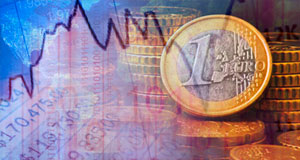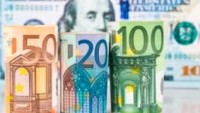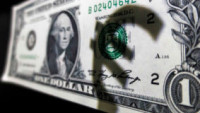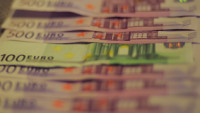 A year ago today the European Central Bank started its €60bn a month bond buying program and its questionable as to how effective it has been. If the purpose of the program was to help boost asset prices, boost inflation and devalue the euro then on all counts it’s been a failure.
A year ago today the European Central Bank started its €60bn a month bond buying program and its questionable as to how effective it has been. If the purpose of the program was to help boost asset prices, boost inflation and devalue the euro then on all counts it’s been a failure.
Not only are European stock markets lower, but the euro has only lost ground against the Japanese yen, while headline inflation is negative at -0.2%. No doubt advocates of QE will point to the rebound in the economic growth in the euro area over the last 12 months but this rebound is probably more as a result of the decline in energy prices, which has served as an economic boost across the global economy.
Despite rising concerns about the effectiveness of the current policy, later today investors will be looking to the ECB to do more of the same, against a backdrop of concern about the damage negative rates are having on the financial health of some of the weaker banks in the euro area, particularly in Italy and Greece, where the number of non-performing loans are causing serious concerns about the solvency of the entire banking system.
In a strange quirk of timing inflation elsewhere in the world is starting to show some signs of picking up with the recent stabilisation and rebound in commodity prices, here in the UK and US there is some evidence that prices are rising and the latest Chinese CPI numbers also reflect that coming in this morning at 2.3%, up from 1.8% the previous month.
Expectations are for ECB President Mario Draghi to set aside concerns about negative rates from senior banking figures and announce another cut in the deposit rate from -0.3% to -0.4%.
At the same time the ECB is expected to boost the monthly bond buying amount from €60bn to €70bn, despite warnings from the Bank for International Settlements, and the IMF’s managing director David Lipton of navigating further into the murky waters of negative interest rate territory.
If the ECB does move in this fashion it will be merely tinkering around the edges given that German 2 year yields are already down at -0.539%, well outside the ECB’s ability to buy, which suggests to have an effect a deeper deposit rate cut would be needed, a highly risky move given concerns about European banks.
At the most recent count it is estimated that there are over $6.6trn worth of bonds returning a negative yield, a truly frightening prospect in a world where debt levels continue to rise.
At the end of last month the G20 acknowledged in its communique that monetary policy wasn’t enough on its own to boost global growth, and that structural reforms were also needed. This is a point that ECB President Mario Draghi has consistently made since his “whatever it takes” speech in 2012.
Since that day progress on that front has been glacial and despite Draghi’s insistence that there is “no limit” to the ECB’s ability to hit its targets it is becoming increasingly clear that for every action the ECB takes there is an equal and proportionate reaction by other central banks around the world with any action taken today likely to be matched by the Swiss National Bank as well as the Danish, Swedish and probably the Chinese central banks in the coming days.
The extent of the ECB’s problem was crystalized by events in France yesterday as protestors took to the streets to demonstrate against French President Francois Hollande’s proposed minor labour market reforms, which include removing the rigidity of the 35 hour week. Other measures include more flexibility in the hiring and firing of employees, which currently make French companies extremely reluctant to take on new staff, hence the fact that unemployment is at an 18 year high.
It is not only in France that politicians have been reluctant to grasp the nettle of structural reform but all across Europe with Italy, Greece and Germany all guilty to a greater or lesser extent.
Against this backdrop while the ECB can continue to double down on the stimulus front the ability of such actions to have any sort of positive effect will continue to diminish, something markets and investors are slowly starting to realise.
Amidst all this speculation the euro has continued to hold up fairly well and while the natural reaction would be to sell the currency, the shadow of December’s disappointment hangs over the market, which suggests that whatever the ECB does today may not be enough to stop the currency moving higher.
It is also hard to ignore the fact that the Japanese yen went up after the Bank of Japan cut rates. Could the euro do the same, irrespective of what Draghi does today? Something to ponder perhaps.
EURUSD – the 200 day MA at 1.1050 remains a key resistance, with a break targeting the 1.1200 area. Support remains at last week’s low at 1.0800, with a break targeting 1.0600.
GBPUSD – continues to look well supported on dips with the potential for further gains towards 1.4400. To maintain the current momentum we need to hold above 1.4140 trend line support from the recent lows to keep the bullish momentum intact. A fall below 1.4080 retargets the lows at 1.3835.
EURGBP – the potential for further losses towards 0.7520 remains intact while below the 0.7830 level. We need to get below support at 0.7690 for this to unfold, to keep bearish scenario intact.
USDJPY – currently range bound between support at 111.00 and resistance at 114.90 we need to see a break one way or the other for clues as to the next move. The bias remains towards the downside towards 106.00 while resistance at 114.80 remains intact. Above 115.00 argues a short term base is in place.
Source: CMCmarkets
Other useful information for traders:
- Forex Forecasts & Analysis
- Forex Brokers Reviews
- Rating Forex Brokers
- FxPro Reviews












